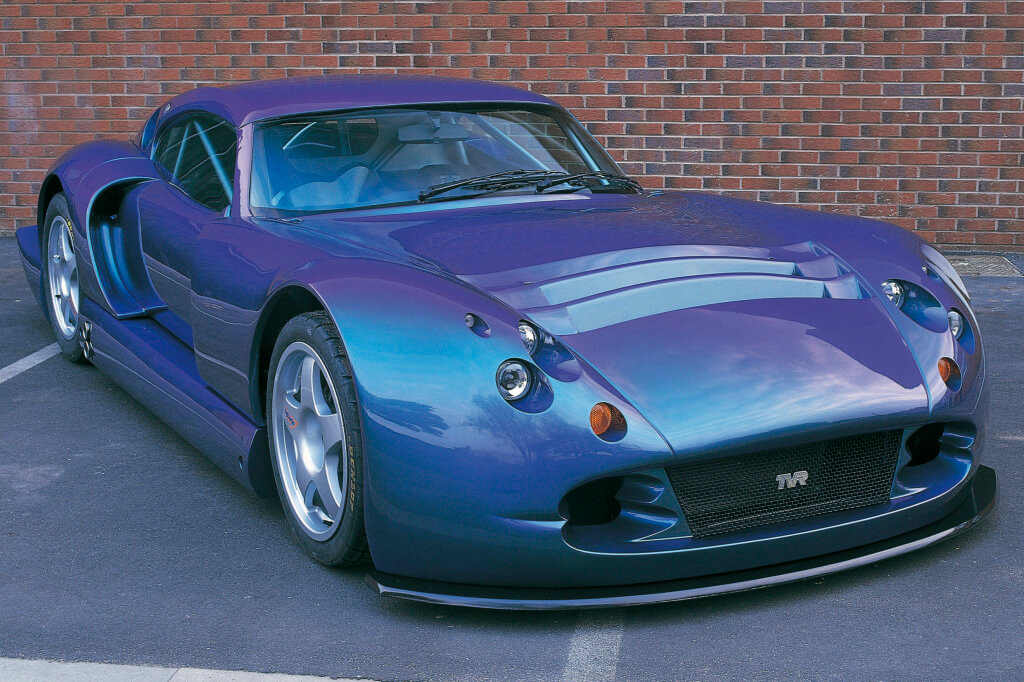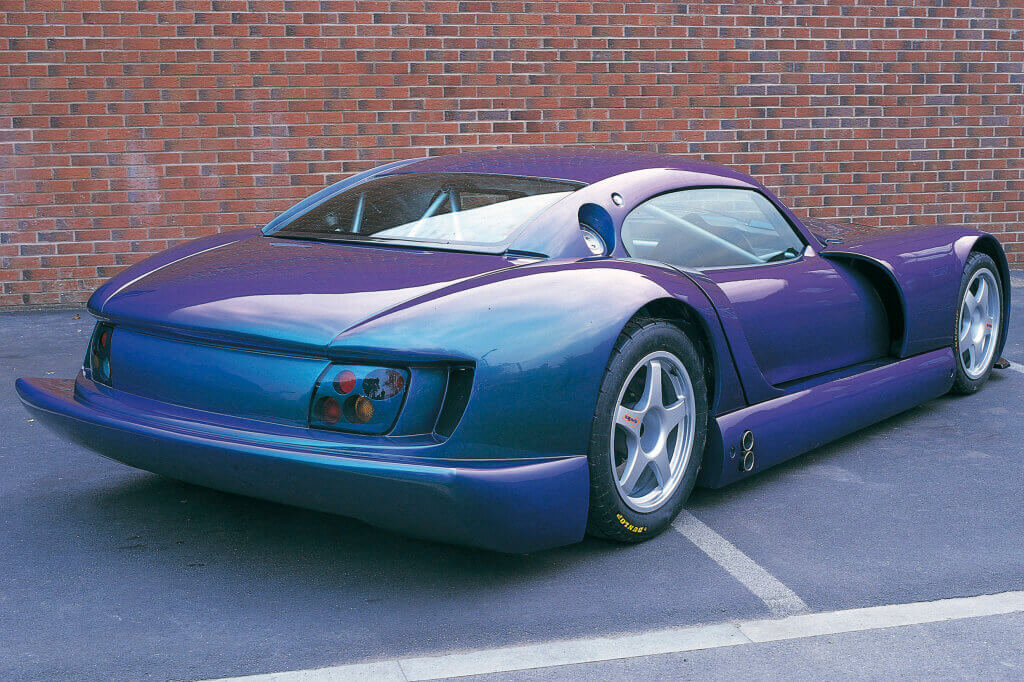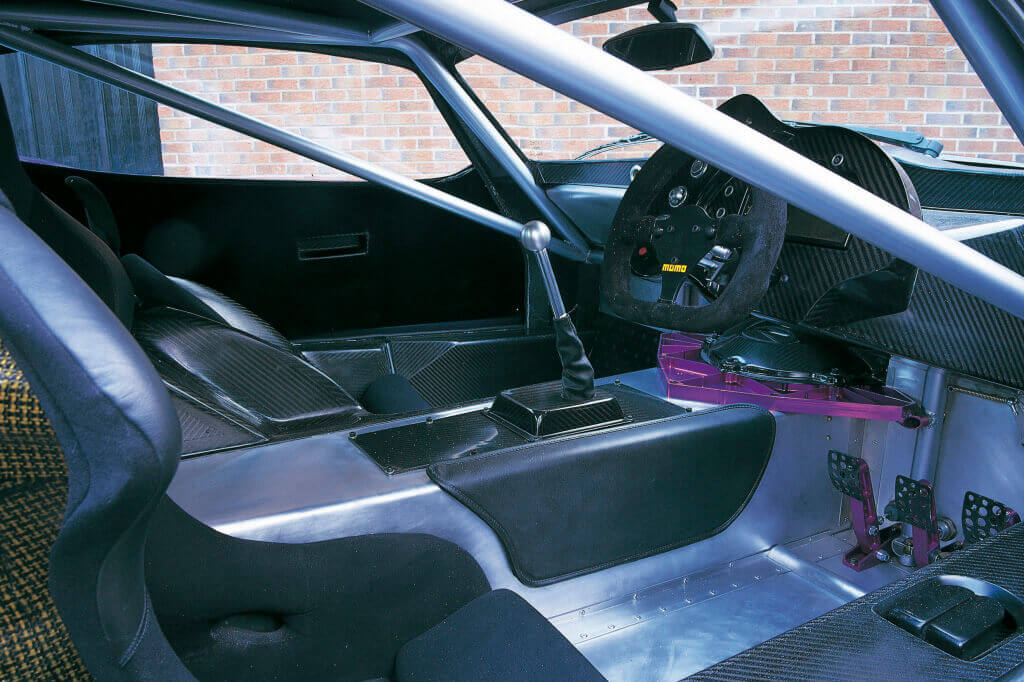TVR Cerbera Speed 12 Prototype
Description
The idea of creating a supercar project for GT1 class competitions was born in 1996. A concept called Project 7/12 was unveiled at the 1996 Birmingham Motor Show. The first prototypes appeared in 1998, but changed regulations prevented Project 7/12 from taking part in the planned racing series. Then the company's management decided to convert the car to participate in the GT2 class. This is how the TVR Cerbera Speed 12 was born, and the racing version is called the Speed 12 GTS. The goals of the developers were also to create a McLaren F1 competitor that not only had to beat one of the McLaren parameters, but surpass it in everything.
The prototype got its name Speed 12 from the concept engine used, which was developed by connecting two cylinder blocks of the TVR AJP6 (Speed Six) engine to a common crankshaft (by the way, the cylinder block was not cast iron, but steel). It also featured a revised cylinder head design with revised valve trains. The completed 7.7 liter engine was originally planned for racing versions of the Speed 12 GTS.
Since the supercar did not take part in the 24 Hours of Le Mans, it started in the British FIA GT Racing Championship, but there, in accordance with the regulations, the engine had to produce no more than about 700 hp. As a result, engineers had to limit engine power. No restrictions were needed for the road version of the engine. According to reports from TVR engineers, during bench testing, the engine broke the center shaft of their 1000 hp dyno without restraint. Engine power was later theoretically estimated at 960 hp. (700 kW), because each of the V6 engines was tested separately, and each developed an output of 480 hp. The enormous power and high cost of using it was the main reason that only five engines were built.
A 6-speed manual gearbox made by Hollinger sent all the 881 Nm of torque to the rear axle. The installation of such an engine required a reconfiguration of the brake system, which now consisted of 15-inch ventilated discs with six-piston calipers at the front and 11-inch discs with four-piston calipers at the rear, as well as an ABS system, which was rare for such powerful cars of those times. Excellent traction on the road provided 18-inch Goodyear tires, dimension 245/35 in front and 335/30 in the rear. And all this combined made the car much faster than its main rival, the McLaren F1, in which the limiter did not allow to accelerate over 375 kph without harm to its gearbox, while the Speed 12 was able to squeeze out the maximum 386 kph. After all, more power and less weight should have a positive effect on dynamics. As a result, acceleration to hundreds of the Cerbera Speed 12 took a little less time, and was carried out in 3.1 seconds against 3.2 seconds for the McLaren.
The development of the TVR Cerbera Speed 12 was carried out in the strictest secrecy. The engineers focused on reducing aerodynamic drag and increasing engine cooling. Both parameters became ideal only when creating a wedge-shaped car. But this form made the car very low, which prevented a comfortable landing and disembarkation. In addition, the seats were positioned low and farther from the steering wheel and pedals than usual, and the space in front of the passenger seat was traversed by a steel roll cage tube.
To solve the problem of engine cooling, a special design of the front bumper was developed, into which the radiator grille and twin air intakes were integrated. They cooled the huge front disc brakes. Holes were provided in the front fenders to remove hot air from the engine.
The unusually long rear bumper more effectively played the role of a wing, pressing the car to the roadway at high speeds, it did not create almost any resistance to the air flow.
The body itself was very light, as it was made of carbon fiber and composite materials using Kevlar, but for a greater level of rigidity and safety, a steel roll cage was integrated into the cabin. The bottom of the car was completely flat, which greatly improved the level of stability at high speeds.
Asceticism reigned in the cabin, and starting the engine was a whole ritual: first it was necessary to warm up the oil, then pump up gasoline, and only then activate the starter button.
Sources
Specification
| Bodywork | |
|---|---|
| Years of production |
1999
|
| Produced (pcs.) |
1
|
| Body type |
купе
|
| Number of doors |
2
|
| Number of places |
2
|
| Engine | |
|---|---|
| Engine type |
бензиновый
|
| Engine location |
спереди, продольное
|
| Engine model |
TVR Speed 12 V12 7.7L
|
| Cylinders |
V12
|
| Capacity (cc) |
7730
|
| Power output (hp / kW /) |
811 /
597 /
|
| at rpm |
7250
|
| Torque (N·m) |
881
|
| at rpm |
5750
|
| Bore (mm) |
96,0
|
| Stroke (mm) |
89,0
|
| Compression |
12,5
|
| Number of valves |
4/48
|
| Valvetrain |
DOHC
|
| Block material |
сталь
|
| Fuel system |
впрыск
|
| Turbocharger |
—
|
| Specific | |
|---|---|
| Specific output (hp/litre) |
104,92
|
| Specific output (hp/tonne) |
831,79
|
| Specific output (kg/hp) |
1,20
|
| Specific torque (N·m/litre) |
113,97
|
| Specific torque (N·m/tonne) |
903,59
|
| Transmission | |
|---|---|
| Driven wheels |
задний
|
| Gearbox model |
Hollinger
|
| Gearbox |
механическая
|
| Number of speeds |
6
|
| Suspension | |
|---|---|
| Front suspension |
push-rod
|
| Rear suspension |
push-rod
|
| Elastic elements in front |
пружины
|
| Elastic elements in rear |
пружины
|
| Front anti-roll bar | |
| Rear anti-roll bar | |
| Wheel size front |
11,0J×18
|
| Wheel size rear |
13,0J×18
|
| Tire brand |
Goodyear F1 Fiorano
|
| Tyres front |
245/35 R18
|
| Tyres rear |
335/30 R18
|
| Steering | |
|---|---|
| Steering type |
шестерня-рейка
|
| Brakes specs | |
|---|---|
| Brakes front |
дисковые вентилируемые
|
| Brakes rear |
дисковые вентилируемые
|
| Front brake diameter (mm) |
378
|
| Rear brake diameter (mm) |
273
|
| Number of caliper pistons (front/rear) |
6/4
|
| Anti-lock braking system |
да
|
| Dimensions and weight | |
|---|---|
| Body |
стальной трубчатый каркас
|
| Body material |
углеволокно
|
| Length (mm) |
4360
|
| Width (mm) |
2030
|
| Height (mm) |
1160
|
| Wheelbase (mm) |
2642
|
| Curb weight (kg) |
975
|
| Performance specs | |
|---|---|
| Fuel type |
бензин
|
| Dynamic specs | |
|---|---|
| Acceleration 0-100 kph (s) |
3,1
|
| Acceleration 0-60 mph (s) |
2,9
|
|---|
| Top speed (kph) |
338
|
|---|---|
| Top speed (mph) |
210
|



